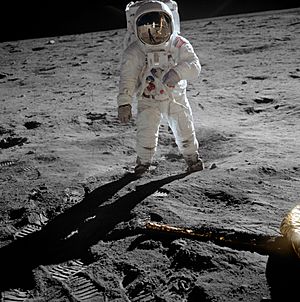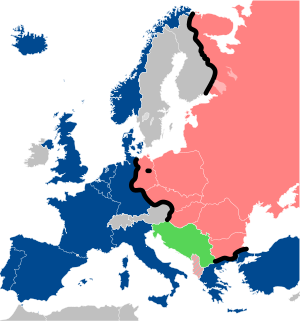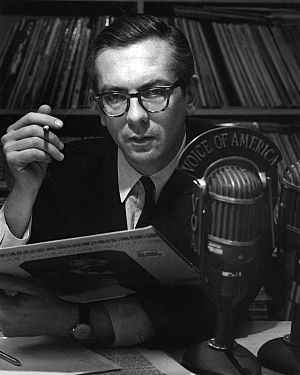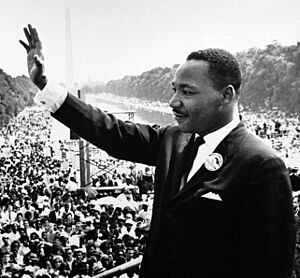Voice of America facts for kids
 |
|
| Abbreviation | VOA or VoA |
|---|---|
| Founded | February 1, 1942 |
| Type | International state-funded broadcaster |
| Headquarters | Wilbur J. Cohen Federal Building |
| Location |
|
|
Director
|
Michael Abramowitz |
|
Budget (Fiscal year 2023)
|
US$267.5 million |
|
Staff (2021)
|
961 |
Voice of America (VOA or VoA) is a news network that broadcasts around the world. It is funded by the federal government of the United States. VOA is the largest and oldest of the U.S. international broadcasters. It creates digital, TV, and radio content in 48 languages. This content is shared with stations all over the world.
VOA's main audience is people outside the United States. This is especially true for those living in countries where the press is not free or where there is no independent news.
VOA started in 1942, during World War II. It was first used to fight against false information from countries like Germany and Japan. Later, it also shared American music and culture. During the Cold War, VOA helped fight against communism. It aimed to share uncensored news with people living under strict governments. Some countries tried to block VOA broadcasts, but the news still reached many listeners.
VOA's main office is in Washington, D.C. It is overseen by the U.S. Agency for Global Media (USAGM). This agency is funded by the U.S. Congress. In 2022, about 326 million people around the world listened to or watched VOA each week.
VOA has sometimes been called propaganda. However, laws have been put in place to keep its reporting accurate and independent. In 1976, U.S. President Gerald Ford signed the VOA charter. This law says VOA's news must be "accurate, objective, and comprehensive." Another law from 1994 stops government officials from changing VOA's news. These laws are called VOA's "firewall."
Contents
What languages does VOA use?
The Voice of America website has five English-language broadcasts. These include a worldwide service and one for people learning English. The VOA website also has versions in 48 other languages.
Radio programs are marked with an "R"; television programs with a "T":
- Afan Oromo R
- Albanian R, T
- Amharic R
- Armenian T
- Azerbaijani T
- Bambara R
- Bangla R, T
- Bosnian T
- Burmese R, T
- Cantonese R, T
- Dari Persian R, T
- French R, T
- Georgian R
- Haitian Creole R
- Hausa R
- Indonesian R, T
- Khmer R, T
- Kinyarwanda R
- Kirundi
- Korean R
- Kurdish R
- Lao R
- Lingala R
- Macedonian T
- Mandarin R, T
- Ndebele
- Pashto T
- Persian R, T
- Portuguese R
- Rohingya
- Russian T
- Sango R
- Serbian T
- Shona R
- Sindhi
- Somali R
- Spanish R, T
- Swahili R
- Thai R
- Tibetan R, T
- Tigrinya R
- Turkish T
- Ukrainian T
- Urdu R, T
- Uzbek R, T
- Vietnamese R, T
- Wolof
- English R, T
The number of languages VOA uses can change. This depends on what the United States government thinks is important in the world.
VOA's History
How VOA started during World War II
Before World War II, private companies ran all American shortwave radio stations. These stations broadcast in many languages. They were important for sharing news.
In 1939, the U.S. government said these stations should share American culture. They should also promote friendship between countries. This was to counter bad information from other nations.
The U.S. government started providing war news to these stations. The first VOA broadcast was on February 1, 1942. It was sent to Germany and was called "Voices from America." The broadcast promised to "always tell you the truth." This was the start of the Voice of America.
By the end of the war, VOA had 39 transmitters. It broadcast in 40 languages. Programs included music, news, and discussions. About half of VOA's services stopped in 1945. VOA then became part of the U.S. Department of State.
VOA during the Cold War
VOA grew a lot during the Cold War. This was a time of tension between the U.S. and the Soviet Union. VOA aimed to fight communism. Many people listened to VOA, even behind the Iron Curtain. This was a term for the border separating communist and non-communist countries in Europe.
VOA started broadcasting to the Soviet Union in 1947. The Soviet Union tried to block these broadcasts. They used radio jamming to stop the signals. But VOA still reached many people. People who left communist countries often said VOA helped them decide to leave.
From 1955 to 2003, VOA had a popular show called Voice of America Jazz Hour. It played American jazz music. At its peak, 30 million people listened to it. This show helped share American culture around the world.
In 1954, VOA moved its main office to Washington D.C. During the Hungarian Revolution of 1956, VOA's broadcasts were important. People in Hungary thought VOA hinted at help from Western countries.
Many governments tried to block VOA broadcasts during the Cold War. For example, China still tries to block VOA today. But people often found ways to listen.

In the 1960s and 1970s, VOA covered big news events. These included Martin Luther King Jr.'s "I Have a Dream" speech in 1963. They also covered Neil Armstrong's first walk on the Moon in 1969. Millions of people listened to these broadcasts.
In the 1980s, VOA improved its broadcasting technology. It also added a television service. VOA expanded its programs in Mandarin and Cantonese in 1989. This was to inform people in China about the pro-democracy movement.
After the Cold War
After the Soviet Union broke up, VOA added more language services. This was to reach new areas in Eastern Europe. They added services in languages like Tibetan and Kurdish.
In 1994, VOA became the first news organization to offer constantly updated programs on the Internet.
VOA's Policies
The VOA Charter
In 1976, President Gerald Ford signed the VOA Charter into law. This charter sets out the rules for VOA broadcasts. It says VOA must be a reliable source of news. The news must be "accurate, objective, and comprehensive." VOA should also show a balanced view of American ideas and institutions. It should clearly explain U.S. policies.
The "Firewall"
The "firewall" is a policy that protects VOA's journalism. It was put in place with the 1976 VOA Charter and other laws. This policy helps make sure VOA's news is unbiased and objective. It fights against propaganda.
The "Two-source rule"
VOA has an internal rule for its news stories. Any story broadcast must have two different sources that confirm the information. Or, a VOA reporter must have seen the event themselves. This helps ensure the news is accurate.
VOA in Different Regions
China
Studies have looked at how VOA affects Chinese students and scholars in America. Some studies found that VOA helped students disapprove of the Chinese government's actions. It also influenced the political beliefs of some scholars.
Pakistan
VOA's DEEWA Radio broadcasts in Pakistan. Some listeners felt the programs gave a voice to people who were not heard before. In 2018, Pakistani authorities blocked VOA's Pashto and Urdu language websites.
Russia
In 2017, Russia's Justice Ministry called Voice of America a "foreign agent." This was in response to the U.S. asking a Russian TV network to register as a foreign agent.
Turkey
In 2022, Turkey's media watchdog blocked VOA's website in Turkey. They said VOA had not applied for a necessary license. This license would have made VOA follow certain rules. VOA said it could not agree to rules that would lead to censorship. VOA Turkish then shared ways for people to access its content using special internet tools.
Images for kids
- List of public broadcasters by country
- List of state media by country
- List of world news channels
See also
 In Spanish: Voz de América para niños
In Spanish: Voz de América para niños







